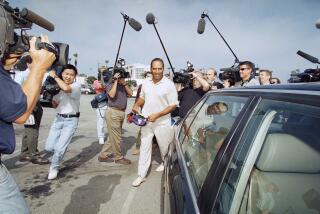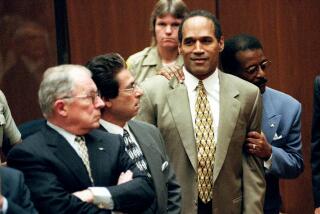Overell and Gollum--The Most Famous Trial in the Old Courthouse
- Share via
The voice on the other end of the telephone is down-home, friendly and matter-of-fact as he answers questions about his sensational murder trial, now 41 years behind him.
No, his neighbors today probably do not know about his once all-too-public past. No, he does not still think about that fateful night when his fiancee’s wealthy parents were blown apart on their yacht in Newport Harbor.
And no, George Rector Gollum said, he did not do it.
The year was 1947. Americans, rebounding from the war, were happily devoting themselves to their homes and families. It was a time of hope and promise.
And so it was with special horror that people across the nation latched onto news from sleepy Orange County, where Beulah Louise Overell and her fiance, George (Bud) Gollum, were accused of coldbloodedly bludgeoning her parents--who reportedly objected to their marriage plans--and then covering up the crime by dynamiting the victims’ yacht.
“We had lust, we had greed, we had frustration. Ladies and gentlemen, these are the raw materials out of which murders are made,” the prosecutor told the jury in his opening statement.
It was the most famous trial ever held in the Old County Courthouse in Santa Ana. Hollywood could not have staged a more gripping melodrama.
There were the frankly less-than-attractive 18-year-old heiress and her handsome fiance, a 21-year-old premed student. There were courtroom dramatics--at one point Overell’s attorney pulled a handful of screws out of his pocket and showered them over the courtroom to refute the prosecutor’s argument about the rarity of the clock parts used in the bomb. There were out-of-courtroom dramatics--searing love letters exchanged between the jail cells of Beulah and Bud and intercepted by authorities, then leaked for all to read in the newspapers.
And there was the verdict.
“The judge cautioned the audience to be quiet (before the verdict was read), but that didn’t do much good,” recalled Lecil Slaback, the court reporter for the trial. The courtroom was packed and hundreds spilled out into the hallway and down into the street, crowding onto the courthouse lawn.
As soon as the first of the two “not guilty” verdicts was read, “everyone clapped and hollered and carried on,” Slaback said. Even outside the courtroom, where the crowd listened to the verdict over the radio, “a huge cheer went up,” said attorney Robert Jacobs, whose father, Otto Jacobs, successfully defended Beulah Overell.
But seven months earlier, authorities investigating the fatal blast aboard the 47-foot cabin cruiser Mary E in Newport Beach were certain that all evidence pointed to the guilt of Overell and Gollum.
According to Overell’s own statement to her attorney, the day before her parents died, she and Gollum drove to Chatsworth and bought some dynamite at the request of her father, Walter Overell, a Los Angeles businessman.
“I said what did (her father) want it for, and he (Gollum) replied that he didn’t know, that (he) had just asked him to get some,” Overell wrote in her statement, contained in attorney Otto Jacobs’ files on the case--three overflowing boxes of papers, clippings and transcripts kept at the family’s El Toro law firm.
The next day, March 15, Overell went with her parents from their La Crescenta home to their boat, which mechanics were working on, and met her boyfriend there. About 11 p.m., her father sent them to pick up some hamburgers, she told her attorney. When they returned, the Mary E had exploded.
Authorities later found 31 sticks of unexploded dynamite on the boat, according to a news account. The exploded dynamite had been set off by a clock attached to the boat’s battery. According to newspaper reports, authorities also learned that Overell’s parents were bitterly opposed to their daughter’s marriage plans. And authorities believed that the parents had been beaten before the boat explosion.
A grand jury indicted the pair, and Overell’s relatives hired Otto Jacobs, a veteran attorney who by that time had handled 80 major criminal cases, including eight murder cases, and had won them all. He was aided by Z.B. West. Gollum was represented by S.B. Kaufman.
Before the case was even heard by a jury, though, the public was titillated by reading the private love letters passed between the two defendants separated by bars. The missives--including pet names, an occasional suicide threat and one mention of a planned jailbreak, with map included--had been carried by a jail guard, intercepted by authorities and somehow obtained by the Los Angeles Examiner.
“Would you still marry me if I were broke? Oh Pops darling, please promise you will marry me,” Overell wrote in one letter. In another, she told her fiance: “You’re an uplifted human being. You’re the most intelligent person I ever heard of. Einstein was a moron compared to you. . . . Yes, sir, you’re the object of my adoration and the creature of my determination.”
And from Gollum to Overell: “ . . . If you ever leave me or are unfaithful to me or stop loving me, I will take that overdose of sleeping pills. After I have killed the man you turned to from me. That is a promise. . . .”
Jacobs later argued that the couple were entrapped into writing the letters so that they would fall into the hands of the prosecutors, who would use them against the lovers in the trial. Indeed, one of the prosecutors said in court of the letters:
“We find lust, lust and more lust . . . greed, greed and more greed . . . perversion and continuing perversion . . . money . . . jealousy . . . thoughts of suicide and jailbreak . . .
“We find a passion so strong that it transcends all morals. But do we find any expression whatever of innocence? Any expression whatever of horror? No!”
The sensational press coverage that included the love letters only intensified with the start of the trial. In addition to the Orange County and Los Angeles newspapers, Life and Time magazines, New York newspapers and wire services were there. Radio station KWIZ, then KVOE, broadcast the trial live. The Los Angeles Examiner sent in noted Hearst columnist Adela Rogers St. John to write her observations.
In one column, she pontificated about how the two lovers looked older than their years and how inappropriately Overell dressed during mourning.
“Whether Louise Overell is guilty as charged or whether she is only an orphan who lost both mother and father . . . , she wears in the courtroom clothes which show no acknowledgement of her loss,” St. John wrote, criticizing Overell’s bright clothes and “her heavy hair, dark brown and streaked with henna red . . . held back by a huge gold pin, suitable for dancing . . .”
Press accounts at the time of the trial said Otto Jacobs suggested that Walter Overell set off the dynamite himself, either accidentally or intentionally. But that was not the foundation of Beulah Louise Overell’s defense.
Instead, Otto Jacobs methodically chipped away at the prosecutors’ evidence, pouncing on their errors, suppositions and, at times, their lies, Robert Jacobs said.
One big moment came when one of the prosecution’s expert witnesses testified that he had found in Gollum’s car a screw from the clock used in the bomb. This was an unusual screw, the witness testified; linking it to Gollum’s car was damning testimony.
But it turned out that the screw was not so rare, after all.
“So my dad went to a jewelry place and bought a barrel of them. It was quite an exciting event in court. He filled his coat pocket with these dinky screws, and in cross-examining the expert, he pulled a handful out. There were screws all over the courtroom.”
The defense attorney also tore apart the shabby medical examinations that had been performed on the bodies, disputing that the couple had been beaten before the blast. He further argued that, contrary to the prosecutors’ contentions, it could not be proved that Mrs. Overell had been attacked with a ball peen hammer, nor could it be proved that a stanchion from the boat--allegedly the murder weapon used on Walter Overell--had ever been removed from the vessel.
The prosecution’s case, Otto Jacobs told the jury in his closing argument, was built on “possibilities, probabilities and a lot of myths.”
After the acquittals, no one else was ever arrested, and Beulah Louise Overell went on to inherit her parents’ estate, valued at between $200,000 and $500,000.
Beulah and Bud never married. By the end of the four-month-long trial, things had cooled between them.
“I saw her a couple times after the trial, but it didn’t--you know. Things had just changed too much,” Gollum said in a recent telephone interview. She went on to marry at least twice and died in 1965, at 36, of apparent acute alcoholism, according to a news story. Her nude, bruised body was found in bed in her Las Vegas home with two empty quart vodka bottles near her head and a loaded, cocked but unfired .22-caliber rifle at her feet.
Gollum never went on to medical school. “The trial effectively killed that,” he said. Instead, he worked for a carnival for a while, did a little traveling and wound up serving time in prison, after all. He was caught while riding with another fellow “who was in a car that wasn’t his,” Gollum said wryly. He said he spent nine months in the federal penitentiary in Tallahassee. (Prison authorities in Florida were unable to locate Gollum’s files for confirmation.)
Afterward, Gollum went back to school, eventually earning a Ph.D. in biophysics, he said. He declined to say where he earned his degree because he entered school under an assumed name. “I had trouble getting in,” he said. Even though he was found not guilty, “that’s not how people act,” he added.
He worked several years for a company involved in the development of “over-the-shoulder toss weapons,” an early nuclear device for the Navy, he said. But he got out of the field about 1970 for a variety of reasons, he said, including “the fact that I didn’t like my involvement in nuclear weapons.”
Today, Gollum is 62 and makes a living by buying up large chunks of real estate throughout the western United States, parceling the land up and re-selling it, he said. He lives on 640 acres in a small town in the Sierra Nevada, not far from Lake Tahoe, where he enjoys piloting small aircraft, fishing and photography. He married a carnival motordrome rider soon after the trial, but that marriage was annulled. The father of a daughter and son, he is now separated from his wife of more than 20 years, he said.
He no longer goes by “Bud,” and while he does not encourage publicity about his past, he responds to questions with frank but understated answers. He has cooperated with a couple of authors working on books about his case and with the producers of a television movie that never made it to the screen, but no, he does not want his picture taken for this story. Asked if he ever thought about writing his own book, he responds: “No, I didn’t think it was necessary.”
Is he bothered that some people still suspect he is guilty? No, he said. He doesn’t believe people think about it much anymore; most of the people in his area probably don’t even know about it, and he doesn’t ever bring it up.
“Other than that, one learns to live with it,” he said. “People who know me, know better. And for the others, well, I can’t control that.”
More to Read
Sign up for Essential California
The most important California stories and recommendations in your inbox every morning.
You may occasionally receive promotional content from the Los Angeles Times.













